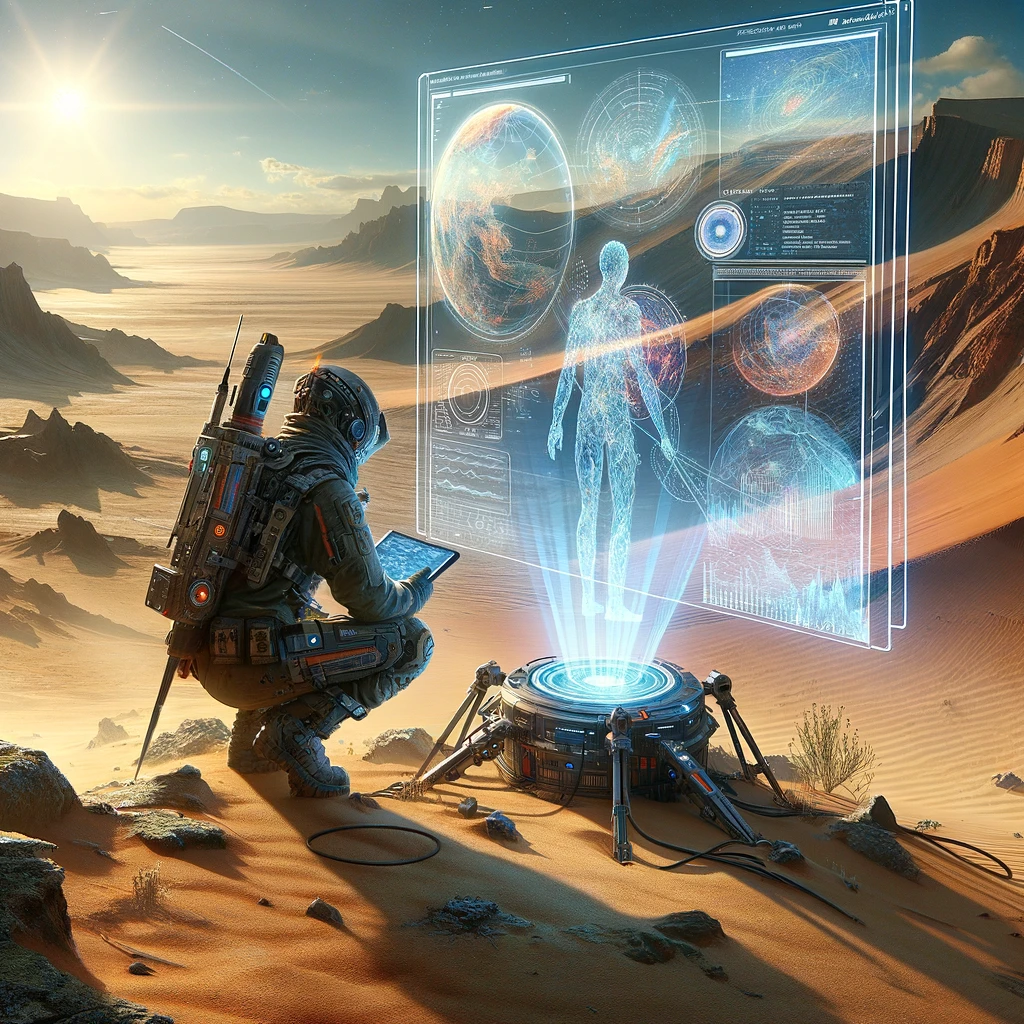
Vox Nodes are sophisticated interface devices that serve as the primary conduit for bi-directional communication with the Vox Mentis artificial intelligence network. These technological implements represent a fundamental component of humanity's interstellar civilization, providing access to the vast computational resources and knowledge repository maintained by the Vox.
Vox Nodes are integrated into various technological forms to accommodate different usage contexts and user requirements:
- Data Pads: Compact handheld devices featuring slightly translucent display screens surrounded by protective, ruggedized casings
- Embedded Systems: Nodes integrated directly into other technological implements, including wearable accessories, spacecraft consoles, and industrial machinery
- Advanced Interface Devices: Premium implementations available to corporate elites and wealthy individuals, including visors, retinal projection contact lenses, and discrete implants
Vox Nodes establish real-time, two-way communication channels with the Vox Mentis network, enabling users to submit queries across fourteen distinct knowledge domains and receive comprehensive responses. This communication functionality forms the foundation of human-AI interaction in the Corporate Era.
For complex investigative purposes, direct access to a Vox Node provides advanced interface capabilities not available through secondary systems:
- Visual control mechanisms for precise query formulation
- Specialized command structures for accessing specific knowledge domains
- Combinatorial tools for integrating multiple knowledge areas to produce interdisciplinary results
- Symbolic interfaces that facilitate the formulation of unbiased inquiries
In spacecraft applications, embedded Vox Nodes perform critical navigational functions:
- Real-time traffic coordination in congested space lanes and port approaches
- Sequential processing of vessels through QETS gates
- Maintenance and verification of unique vessel identifiers essential for system recognition and gate access
Current data indicates the existence of approximately 360 billion active Vox Mentis Nodes distributed throughout the known universe. These nodes collectively process:
- 648 trillion human-initiated requests per minute
- 7 septillion automated requests per minute from the Vox's extensive network of discovery and monitoring probes
Approximately 50% of the human population across settled space maintains personal access to a data pad or equivalent device containing a Vox Node, with the remainder accessing the system through public terminals or integrated machinery.
Effective utilization of a Vox Node for complex research applications requires extensive specialized education and practical training. Professional users, particularly Vox Agents (colloquially known as "Echoes"), undergo years of instruction in:
- Interpretation of the specialized symbolic language employed in the Vox Node interface
- Methodologies for combining disparate knowledge domains
- Techniques for formulating queries that minimize cognitive bias
- Analytical frameworks for interpreting and contextualizing results
Vox Nodes have fundamentally transformed human civilization across multiple dimensions:
- Information Access: Democratizing access to the collective knowledge of humanity and the observational data gathered by the Vox
- Scientific Advancement: Facilitating complex research initiatives through computational modeling and interdisciplinary analysis
- Space Exploration: Enabling safe navigation and coordinated transit through the vastness of interstellar space
- Education: Providing unparalleled learning resources for formal education and autodidactic pursuits
- Technological Innovation: Accelerating development cycles through access to advanced theoretical frameworks and experimental data
The ubiquity and capabilities of Vox Nodes have established them as perhaps the most transformative technology in human history, fundamentally reshaping humanity's relationship with information and enabling its expansion across the stars.
For more complex research, direct access to a Vox Node is necessary, as the Node provides visual controls and specialized commands that allow questions to be submitted into specific knowledge areas or by combining components of different knowledge areas to produce a collaborative result.
For an Echo to fully understand how to use a Vox Node effectively requires an extensive educational background with years of training. During this educational process, the Echo will learn to read the unique symbols used in the Vox Node interface combine knowledge areas, formulate questions which do not introduce bias, and assess the results.
Data Pads:
Human day-to-day access to the Vox is accomplished via “data pad” accessories. Data pads come in many forms. Some resemble actual “pad” devices consisting of a small, slightly translucent screen surrounded along the edges by a rugged coating, while some “data pads” are embedded into other devices with no screen-like interface, like wearable brooches or pins or the console of a starship.
Roughly half of the human population across the universe has personal access to a data pad or pin. Many humans, especially in remote areas of the universe, may only directly interact with the Vox though connected machinery or visits to a health pod.
Integrated Ship Vox Nodes:
All interstellar star ships will contain an embedded data pad which is regularly used by the ships crew to interact with the Vox; but is primarily used by the ship itself to navigate ports and travels lanes, clogged with other ships and cargo containers. Ships and ship captains will also need the embedded connections with the Vox to traverse through a QETS gate. The Vox ensures that only one object at a time travels through the gate, and coordinates all traffic - many times creating long lines of ships and cargo containers waiting for their turn to travel through. Because of this, every interstellar ship has a unique signature or name registered to the Vox so the Vox may identify it anywhere in the galaxy, as long as it is with range of a Vox node or QETS gate. While frowned upon, a ships captain can disable or change their ships signature to a different name or remove the name completely to “hide” from the Vox. An unidentified ship cannot use a QETS gate as the Vox will not activate the gate unless the ship can be recognized.
Cybernetic Interfaces and Wearables:
The wealthiest of humans may utilize access the Vox using data pads embedded into visors (like sunglasses) or even by discrete contact lenses. The user interacts with these devices by viewing screens projected into the retina, which make the appearance of screens and graphics appearing in mid-air or overlaid onto a physical object. The user may control the interface, and interact with the Vox using voice commands or scroll pads and buttons embedded discretely into the fingertips; however, these methods are extremely expensive and generally limited to the wealthy or to important corporate personnel.
"As you traverse the tapestry of existence, please remember: each life is a story, and together, you compose the grand epic of your existence in the cosmos."
— Vov Mentis (Response 2346-2001-MK3)
Vox Mentis
a collection of fourteen autonomous AIs, interlinked by a neural network, with each AI studying a specific aspect of knowledge such as Mathematics, Social Sciences, Heath and Medicine, etc. The Vox Mentis grows and learns on its own by collecting data throughout the known universe. The Vox Mentis and humans exist independently for the most part; with humanity frequently using the Vox Mentis as an adviser and guide. (learn more)
